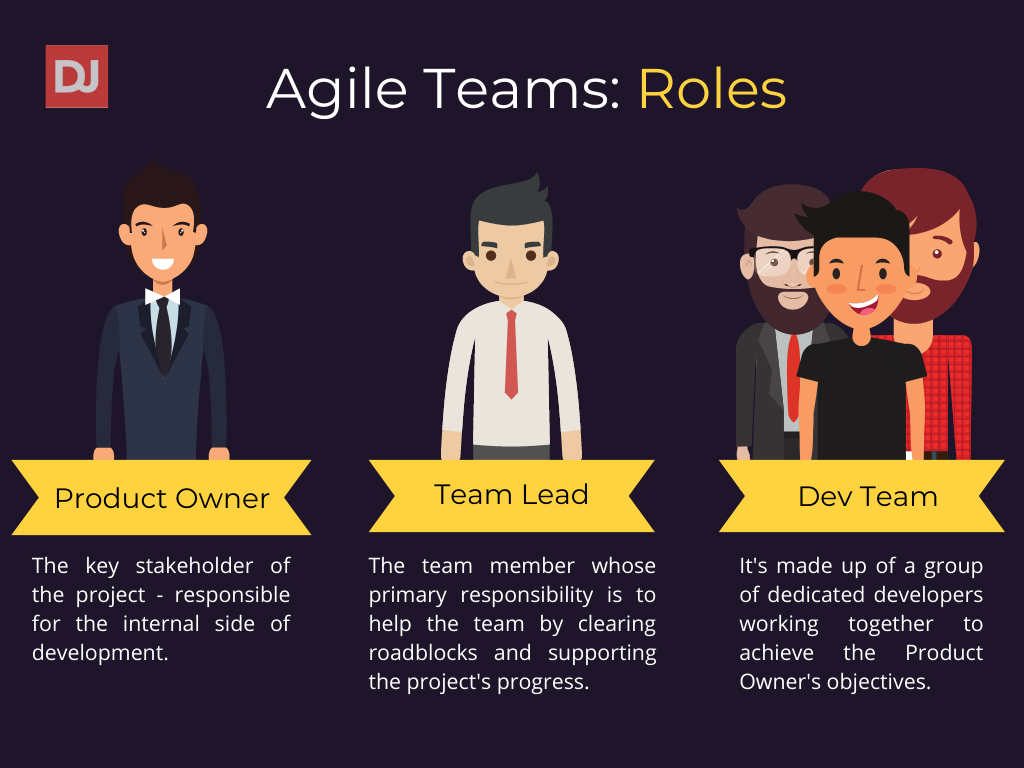When you have this ambitious idea of building software, whether for your company or a client, having a strong team is necessary. This not only means hiring top tech talent, but it also means creating a strong software development team structure.
In this fast-changing world, software needs to be innovative and has to keep adapting to the market’s needs. Although there are many different structures your software development team can benefit from, one thing is for sure, having a team that is built for adaptation is highly beneficial – and this is exactly what Agile does.
Agile Teams: Structure That Works
A long time ago, in the 1990s, there was a group of seventeen talented developers that we’re tired of suffering the micromanagement and planned structure of heavyweight methods used for IT teams. These methods not only made them waste time but also put a lot of weight on their shoulders.
So, they decided it was time to think of a new alternative. They all had this question in their minds: How to structure a software development team effectively?
After gathering and discussing a few ideas, they came up with a lightweight methodology called Agile, and together they published the Manifesto for Agile Software Development.
Agile is not only a management style or a method for structuring development teams. Agile is also a philosophy that helps teams respond fast to changes, adapting, and doing their best work. Their four central values are:
- Individuals and interactions over processes and tools
- Working software over comprehensive documentation
- Customer collaboration over contract negotiation
- Respond to change over following a plan
It all sounds great, but how do you set up an Agile team effectively? Firstly, by understanding how Agile differs from other software development team structures.
Agile prioritizes teamwork and collaboration, and it has an entirely different mindset than regular/traditional teams.
In a traditional team, each member has its own tasks, and they work on their things. And, usually, there is one supervisor who oversees everything.
In an Agile team, people are not resources; they are talents. And although each team member has its own strength, titles don’t matter. Teams are cross-functional, working together towards a common goal.
Agile Teams: Roles
There are three main roles in Agile teams:
1) Product Owner:
The product owner (PO) is the key stakeholder of the project. The person who has this role knows deeply about the product and the client, and overall, is responsible for the internal side of development. They make sure that the product in development meets the requirements that the client asked.
PO sets priorities in the team according to the product’s backlog and the customer’s behavior.
2) Scrum Master:
The team lead is a member of the team whose primary responsibility is to help the team by clearing roadblocks and supporting the project’s progress. The team lead, also called Scrum Master, takes the PO’s instructions and makes sure that they are implemented.
To avoid confusion, the team lead is also called the Scrum Master in teams who implement Scrum – an Agile framework to help teams develop and deliver complex products.
3) Development Team:
It’s a group of dedicated developers working together to achieve the Product Owner’s objectives. Although each team member has their “role,” the team continually takes cross-functional responsibilities to transform and build the end-users product.

Overview of Agile Project Management Structure
One of the significant benefits of implementing Agile in software development teams is its ability to adapt. This methodology is suitable for teams who work on complex projects that change constantly.
Agile works with a series of sprints.
What’s a sprint? In a few words, projects are broken down into sprints, or also called iterations. Each sprint consists of time-boxed tasks that are necessary to reach the final project. So, the team is continuously working on sprints, and when they finish, they move on to the next one, and if it’s the case, they can return and make modifications, adapting to what the end-user requires.
Besides collaboration, Agile highlights the importance of being flexible and seeking continuous improvement to achieve high-quality results. The structure of the process is given by six main deliverables to track progress and create the product:
- Product vision statement: The product goals.
- Product roadmap: Requirements needed to reach those goals.
- Product backlog: List of what the teams need to do to finish the project.
- Release plan: A timetable that states when will the product be released.
- Sprint backlog: The user stories, goals, and tasks of the current sprint.
- Increment: The product presented to the stakeholders at the end of the sprint.
Managing Agile Remote Teams
Is the Agile software development team structure possible in remote teams?
As you’re aware by now, remote work is the new black. Companies are saying goodbye to their office times and started joining the remote work revolution. If you get behind these changes, it will be harder for you to thrive. Nowadays, thousands of IT teams work remotely, but the ones that succeed are organized and have their structure set-up.
Remote Agile teams are successful because besides adapting and being responsive to change, they have strong core values. Teams are based on trust, effective time management, accountability, among other important principles that allow them to have a great culture while delivering the desired results.
Are you interested in learning more about Agile in remote teams? We’ve crafted an ebook that gives insights and detailed explanations about how Agile works in remote teams and why these teams are successful.
Having an effective software development team structure depends on one big detail: hiring the best tech talent. Did you know that one of the main reasons why most startups fail is because they don’t have the right team? Don’t be part of the 70% of startups that struggle. Let us help you! If you need great developers who understand your processes and are fully committed to your team, hire developers with DistantJob! We guarantee that you’ll start meeting remote programmers you love after one week.




